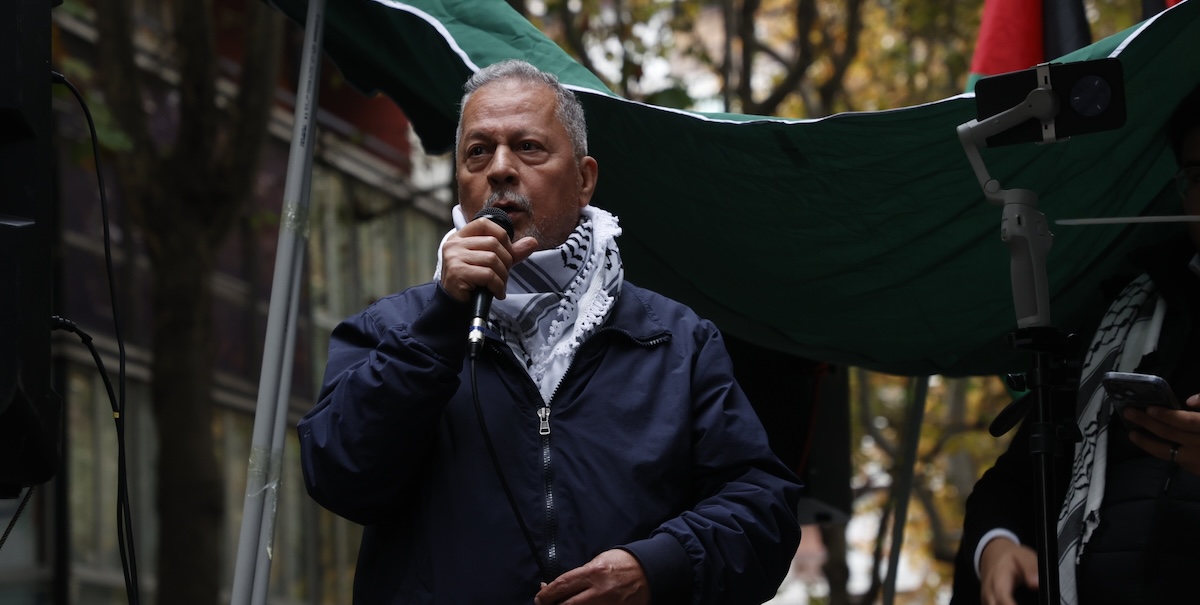Two months that shook Lombardy
How the coronavirus epidemic has shattered the confidence of the richest and most populous region of Italy
di Davide Maria De Luca, Elena Zacchetti, Stefano Vizio, Luca Misculin

Puoi leggere questo articolo in italiano.
The first case of the coronavirus infection in Italy was identified on February 20 at the hospital of Codogno, in the province of Lodi. Within two weeks, the whole country was subjected to some of the toughest quarantine measures taken outside of China. Today, after two challenging months of sacrifice and loss, and with the most critical stage of the emergency behind us, more and more people are starting to look for answers. Tens of thousands of children and grandchildren were not able to say goodbye to their loved ones who died in intensive care wards, at home or in nursing homes. They are now wondering whether everything possible was done to save them. Nowhere are these questions more pressing than in Lombardy, the richest and most populous region of the country and the one that was hit first and hardest by the epidemic.
Every account of this great national tragedy deserves to be told, but Lombardy’s perhaps more than others. In Lombardy more than 14 thousand people have died from the coronavirus, a figure that is incomplete and undoubtedly lower than the actual number. Overwhelmed by the impact of the outbreak, health authorities were unable to keep exact records of the number of deaths caused by the virus, nor could they manage the bodies. Images of military convoys transporting bodies out of the region to be cremated have become a powerful symbol of how everything in Lombardy was engulfed by the pandemic.
Il Post spoke with dozens of doctors, nurses, politicians, virologists and experts as well as ordinary people to gain an initial understanding of what happened in Lombardy, from pandemic preparedness to the peak of the crisis. Although there is no doubt that the picture we have is incomplete, it is a necessary first step in reconstructing an event whose consequences will have a long-term impact on us all.
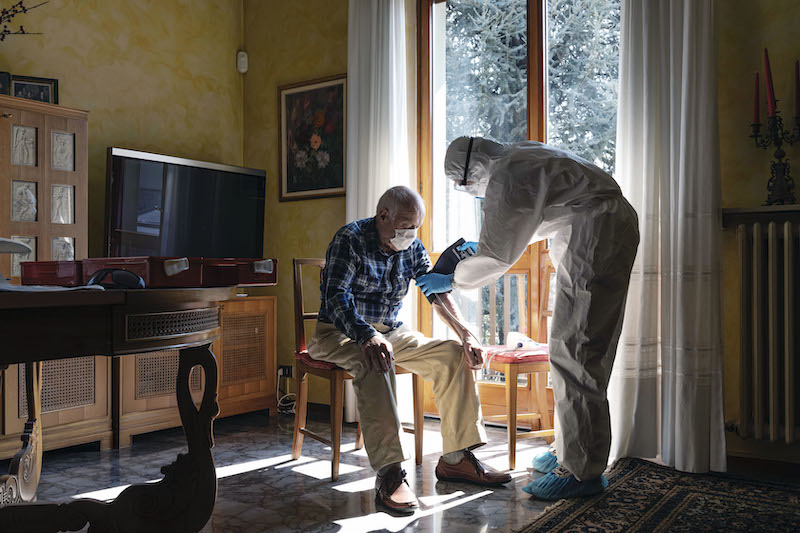
A Red Cross operator during the examination of a patient in Bergamo, April 3 (Marco Di Lauro/Getty Images)
An imminent pandemic
For decades scientists warned governments that the outbreak of a new pandemic was not a question of if, but when. And governments have had this time to prepare. «I smile a bit when I hear so many people quote the prophetic TED Talk of 2015 in which Bill Gates talks about a new pandemic», explained Roberta Villa, medical doctor, scientific journalist and member of the Italian government’s COVID-19 misinformation task force. She was referring to a popular video of the Microsoft’s founder which went viral in the first few weeks of the pandemic.
«In terms of the next pandemic», continues Villa, «in recent years there have been I don’t know how many conferences, meetings, study groups, awareness campaigns, European Commission meetings and World Health Organization alerts».
These warnings started to be taken seriously after the major scares at the beginning of the new millennium: bird flu and SARS, two diseases with pandemic potential. In the decade that followed, governments around the world set up protocols to be implemented as soon as a new pandemic was identified, and made plans to build up stocks of vaccines, antiviral drugs and personal protective equipment. Italy adopted its first pandemic plan in 2006 and the regions, including Lombardy, did so shortly afterwards.
These preparations proved to be advantageous when in 2009 a new pandemic – the first since the late 1960s – was triggered by a variation in the H1N1 virus, the same strain that had caused the deadly Spanish flu a century earlier. Fortunately, the new flu strain proved to be much less virulent than its distant relative. But the weakness of the contagion, combined with the apparent enormity of international mobilisation to combat it, had the opposite effect to the one hoped for by scientists. Governments and international institutions were accused of exaggerating the danger. WHO was accused of colluding with drug companies. In Italy the vaccination campaign was a failure and the government was blamed for signing contracts for millions of doses of vaccines that remained unused.
The emergence of the economic crisis and the budget cuts that followed dealt the final blow. After 2009 the pandemic plans were no longer updated, stocks of medical supplies were not replenished and the lessons that could be learned were forgotten.
According to Villa, the 2009 pandemic was comparable to «a dress rehearsal generously given to mankind». A test that, unfortunately, «ended up being wasted».
In Lombardy, too, the experience of 2009 was not put to good use. In December 2010, just a few months after the official end of the pandemic alert, the regional government received an extremely critical and harsh report from its technical managers regarding the local health system’s response during the swine flu outbreak. The report suggested that only the weakness of the contagion prevented considerably worse consequences.
According to the report, the Lombardy region had not communicated clearly with the population nor with health workers. It had failed to set up statistical systems to measure absences at work, access to emergency rooms and an abnormal number of deaths caused by the disease. The report went on to say that the regional government and health leaders had not coordinated sufficiently with local medical networks, family doctors, clinics and nursing homes. For the latter, which are particularly vulnerable during a pandemic, the report specified that the region had not provided for any procedures to support their staff.
On December 22 2010, the report was approved by the local council. From that day on, it was never spoken of again.
Many of those who have criticised the Lombardy region’s management of the coronavirus pandemic in recent weeks would completely agree with the content of this report, written almost ten years ago in response to the region’s inadequate handling of a different epidemic.
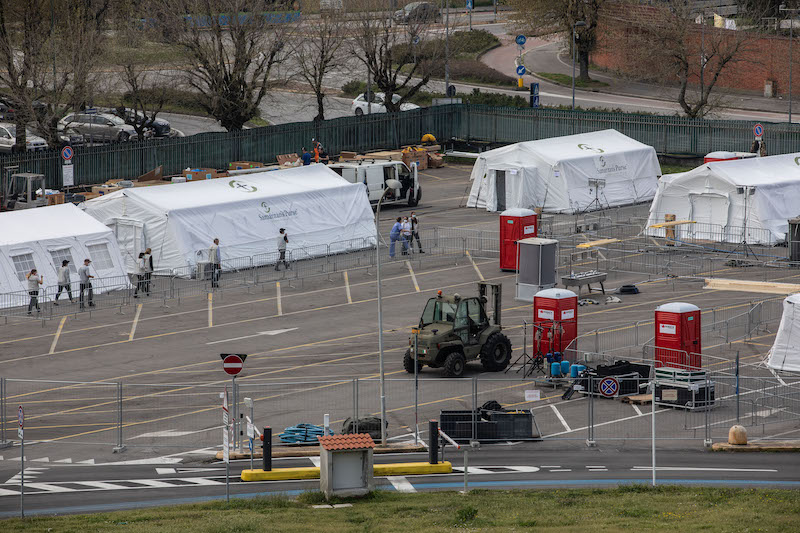
The field hospital built next to the hospital in Cremona, March 20 (Emanuele Cremaschi/Getty Images)
Where better than Lombardy?
Whether it was sufficiently prepared or not, the Lombardy region was considered by many to be the most capable of dealing with a traumatic event, such as an epidemic caused by an unknown virus, thanks to its healthcare system which is regarded as one of best in Italy and Europe. In terms of quality of healthcare, according to the official rankings of the Ministry of Health, Lombardy ranks fifth out of the nineteen regions and two autonomous provinces in Italy. The region is an international hub that each year attracts tens of thousands of patients from the rest of Italy and all over the world.
As the coronavirus pandemic progressed, however, doubts about this healthcare system began to emerge. For some people, its structure, which is practically one-of-a-kind in Italy and consists of a strong private component and a series of large, modern and efficient hospitals, has been an effective barrier to the disease, saving thousands of lives. For others, however, the excellence of the Lombard system has hidden a series of critical issues that explain, at least in part, why the region has been hit so hard.
The Lombard health system that had to endure the pandemic is largely the result of one man’s vision: Roberto Formigoni, the dynamic president of the region from 1995 to 2013, a spokesman of Forza Italia and member of Memores Domini, a confraternity consisting of the most important members of the influential Catholic association Communion and Liberation. Formigoni, driven by liberal ideas and the Catholic doctrine of subsidiarity, created a system centred on «the citizen’s freedom of choice» as he himself claimed. In other words, the freedom to choose whether to be treated by the public or private health service.
Formigoni’s vision was made possible by the healthcare reforms that, since the 1990s, have been making Italian hospitals increasingly similar to companies, with autonomous budgets and professional managers. The reforms in question also grant the regional governments – responsible for healthcare, according to the Constitution – the autonomy to organise the services as they see fit. In Lombardy, the increasing privatisation of the healthcare system took place against a background of regular scandals involving entrepreneurs, healthcare managers and politicians, including Formigoni himself, who in 2016 was convicted for corruption and spent six months in prison. His successors – Roberto Maroni and Attilio Fontana of the Northern League – have maintained the same approach.
Today around half of Lombardy’s healthcare is private: it operates for the most part under an agreement with the public sector, and it is paid by the region to offer the same rates and the same quality of treatment as the public service. In certain areas of the region, private companies have become the main stakeholders in local healthcare. According to studies carried out by Professor Maria Sartor of the State University of Milan, the San Donato Group – the largest private healthcare company in the region – alone collects 14% of the entire regional turnover for hospitalisations: a service that each year amounts to about a quarter of the €19 billion healthcare budget for the entire region.
The fact that the private sector and their contributions to crisis management are so critical for health in Lombardy is at the centre of the current debate on the response to the COVID-19 epidemic.
The most frequently raised point has been repeated for years by critics of the Lombardy regional system: private companies work in the healthcare sector to make profits, and this is reflected in the type of services they offer. Whilst examinations, delicate surgical operations and specialist visits are activities that give a good profit margin, the management of emergency rooms, trauma caused by road accidents, care of the elderly, prevention, and the treatment of rare and extremely common diseases are, on the other hand, unprofitable activities which, for this reason, are mostly left to public hospitals. One concrete consequence of this is that although private healthcare accounts for about half of all healthcare in Lombardy, it provides just over a quarter of the region’s intensive care beds.
The importance of private hospitals, combined with the special attention that the regional authorities have always paid to them, has helped the Lombard system to excel in medicine and to have a particular focus on large facilities: a system that focuses on delicate interventions, which requires sophisticated equipment and specialised doctors.
On the other hand, this means that community health services have often ended up being neglected. Community health services are a network consisting of GP services, out-of-hours services, local clinics and residential care homes, which, according to many experts, currently need the greatest development and investment, particularly in a country like Italy where a growing elderly population requires continuous but low-intensity care. According to the latest data published last March, for example, the region has a shortage of 600 general practitioners and almost 40 thousand hours of out-of-hours healthcare support, a figure that has grown in recent years.
The health reform approved by the region in 2015, the first one since Formigoni’s long governance, should have partly solved these problems, but many feel that it exacerbated them.
Today, hospitals and doctors in the area operate under different healthcare structures and have a different chain of command; furthermore, relations between regional healthcare and general practitioners continue to be very poor. Whilst GPs, self-employed professionals with contracts largely regulated at national level, seek to protect their independence, the region often tries to take resources and skills from them. Lombardy is not the only region to suffer from this problem, but others have managed to achieve better outcomes. During the current crisis, for example, the authorities of Veneto and Emilia-Romagna have often underlined – and rightly so – their healthcare systems’ greater integration with the territory and the more significant role that their family doctors have played in combating the epidemic.
The comparison with foreign countries is even more striking. While in Italy and Lombardy there is still a strong focus on hospitals, international experts and scholars are increasingly drawing attention to their obsolescence and the growing importance that needs to be placed on home care and preventive medicine. The Italian approach has been criticised, among others, by Giuseppe Remuzzi, a doctor from Bergamo who, in his 2018 book La salute (non) è in vendita [Health is (not) for sale], explained how in Italy people continue to visit the emergency room too often instead of seeking help from a local doctor or a small local clinic, and where even children’s flu is treated in hospital.
Remuzzi is very familiar with the Lombard healthcare system. After a long career in the Bergamo Hospital ‘Ospedali Riuniti di Bergamo’, in 2018 he became director of the Bergamo-based Mario Negri Institute, a non-profit research organisation. Lombardy is not often mentioned in his book, but when Remuzzi criticises a system that he considers too focused on care that is profitable and centralised and which is not particularly concerned with developing healthcare in the community, it’s quite clear which region he is referring to. It is this system, which although excellent has also experienced its fair share of conflicts and criticalities, that was bracing itself to face the pandemic in February.
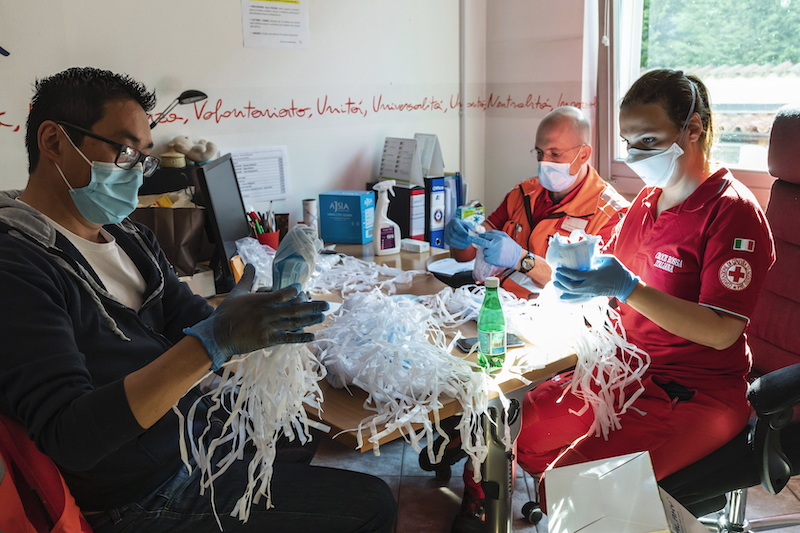
Red Cross operators making face masks to be distributed to the population in Bergamo, April 8 (Marco Di Lauro/Getty Images)
The arrival of the pandemic
In Italy, the pandemic officially started at 9.20 pm on February 20 when the first case of coronavirus was recorded. The so-called “patient one”, a 38-year-old manager known to newspapers simply as Mattia, had visited the small hospital in the municipality of Codogno, in the province of Lodi, a few days earlier with a high fever and cough. The morning after he was hospitalised for respiratory distress, his condition worsened and Mattia was moved to intensive care. It was only thanks to the intuition of an anaesthesiologist that Mattia was tested for COVID-19.
Why intuition was indeed needed? At the time, the test was not recommended by the Ministry of Health for people like Mattia. In a document dated January 27, in fact, only people with serious respiratory illness who had travelled to risk areas in China in the previous 14 days were indicated as suspect cases requiring testing. Nevertheless, the test was carried out at 4.20 pm on February 20 and the result arrived shortly after 9pm. Mattia had tested positive. Patient zero has never been identified. It is now considered likely that the coronavirus has been circulating in Lombardy since December.
In Lombardy, the pandemic has been managed in three phases. The first phase, involving the preparation for the arrival of the virus, ended with the discovery of the first cases in Codogno. The second phase, the one of the “red zones”, began when the health authorities tried to contain the contagion within the epicentre of the outbreak. The third phase, the one in which we still find ourselves, is that which – after containing the virus failed – imposed a generalised quarantine in a bid to suppress the contagion and protect the health system which risked being overwhelmed (as has subsequently happened).
The first phase, that of research and preparation for the arrival of the virus, began on January 22 – a month before Codogno – when the Ministry of Health ordered local health agencies to adopt anti-epidemic protocols. The next day, the Chinese city of Wuhan went into quarantine. A week later the Italian government declared a state of health emergency. Today we know that the four weeks that followed were the last in which the region had time to prepare itself.
The regional government first decided to appoint a crisis unit, composed of the region’s main technicians, heads of hospitals and a number of experts in specific fields. The crisis unit was set up on the sixth floor of the Palazzo della regione in the Civil Protection operations room and coordinated the first attempts to trace the virus. When two Chinese tourists who landed at Malpensa airport on January 31 tested positive, for example, the crisis unit took action to investigate a pizzeria where it was suspected that the two Chinese travellers had eaten.
The region didn’t do much else. The government, on the other hand, issued no particular warning signals. On the contrary, the strict protocol of January 22 which required the testing of all suspicious cases of pneumonia, was replaced on January 27 by a less strict one (which did not require testing for cases such as Mattia’s). The pandemic plans, which had not been updated for years, were of no help: not only were they difficult to apply to a regional healthcare structure that had changed over time, but they contained just a few lines on the importance of stockpiling protective equipment, which would prove to be one of the most effective tools in pandemic management yet also one of the most problematic issues. However, even if these instructions had been followed, without pre-established agreements in place with suppliers, masks would have already been unobtainable at that point. At the end of February, the region made a long overdue attempt to purchase four million masks, however this was unsuccessful when it became apparent that the supplier was unable to deliver.
However, not everyone was so complacent in preparing for the epidemic. In Veneto, at the request of microbiologist Andrea Crisanti of the University of Padua, the regional government took action at the end of January to strengthen their ability to trace the contagion by starting to independently produce the chemical reagents needed to process hundreds of thousands of swabs. At the end of March, the Veneto region purchased a rare machine from the Netherlands that could process up to 9,000 swabs in a day, which significantly increased the capacity for regional testing even in the advanced phase of the epidemic.
In Lombardy there were no operations of this magnitude, and the difficulties in obtaining the necessary reagents became, during the epidemic, one of the most contested problems surrounding the regional government’s management. The lack of reagents was in fact one of the main issues preventing many tests from being carried out, which for weeks were largely reserved for patients in such severe conditions that they required hospitalisation. This policy has prevented not only asymptomatic people but also many people with acute symptoms from being tested – and therefore from being counted. The Veneto region, being able to rely on a laboratory with sophisticated and certified instruments such as the one in Padua, had prevented this situation from occurring by producing the majority of the necessary reagents independently. However, Lombardy preferred to mainly use “official” reagents, those produced by the manufacturers of the machinery supplied, which would have been – and still are – very difficult to source on the market.
In addition to the initial shortage of swabs in Lombardy, as the epidemic progressed insufficient subsequent efforts were made to increase the testing capacity of the laboratories. Lombardy has more than double the population of the Veneto region, has four times the number of infections (bearing in mind that tests were mainly carried out on those with serious conditions) and exactly ten times the number of fatalities. Nevertheless, in April, Lombardy processed on average about 8,520 swabs per day. In Veneto, this figure was around 7,880. These shortcomings regarding testing and the ability to trace the contagion proved to be particularly problematic when the first phase, entailing research of the contagion, moved on to the following one.
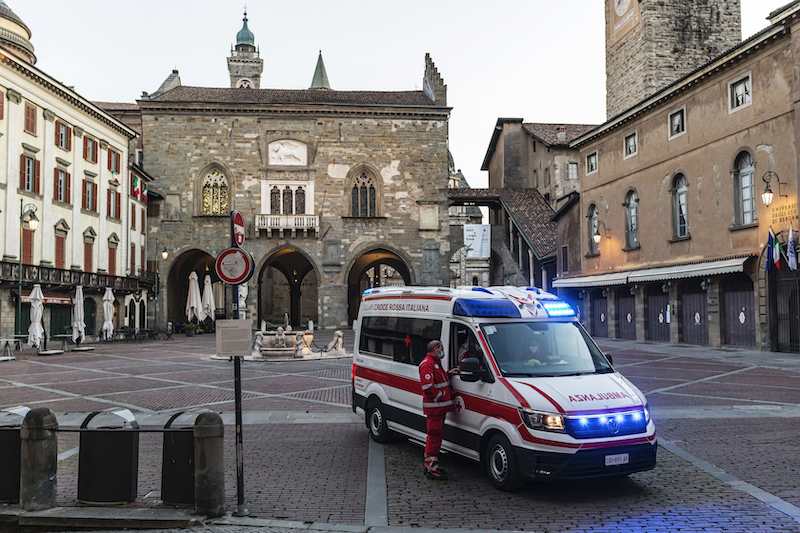
An ambulance in the piazza Vecchia, in Bergamo, Aprile 8 (Marco Di Lauro/Getty Images)
Containment
The second phase in the management of the pandemic emergency began after the first cases in the province of Lodi were identified. On the evening of February 21, the hospital of Codogno was closed and two days later, on the night between the 22 and 23, the government decided to establish fully quarantined areas in ten municipalities in the Lodi area and in the municipality of Vo’ in the province of Padua. All economic activities in these areas were suspended and the population was prevented from leaving in a bid to limit the spread of the virus and prevent it from reaching other areas. These areas were the first “red zones” and in the following days they proved to be a success. On March 10, less than three weeks after the “red zone” was established, no new cases of the virus were identified in Codogno.
But when a case similar to that of Codogno was discovered in the province of Bergamo, the Lombardy region and the national government decided to act in a different way.
In the afternoon of February 23, two new cases of COVID-19 were identified in the small hospital of Alzano Lombardo at the mouth of the Val Seriana valley, a heavily industrialised area just outside Bergamo. As for Codogno, the hospital directors ordered the immediate closure of the emergency room and the isolation of the entire building. Two hours later, however, the region ordered for everything to be reopened. Several witnesses said that the sanitisation procedures prior to the reopening were carried out quickly and inadequately. Despite the enormous risk of contagion in the hospital – a place occupied by doctors and vulnerable patients – no “red zone” was imposed in the municipality, and the Lombardy region said that no further quarantine measures were under consideration.
The failure to close the hospital in Alzano and to apply a “red zone” in Val Seriana have become two of the most controversial issues of the entire crisis. But it is still not easy to assign clear responsibilities.
In the days following the discovery of the first cases in Codogno, the mood in the town and in Lombardy shifted. After the initial scare, an opposite reaction had spread which downplayed the danger of the pandemic and aimed to maintain the people’s confidence.
In Milan, the mayor Beppe Sala published on social networks a video made by a group of local restaurateurs proclaiming that “Milan does not stop”. The secretary of the Democratic Party, Nicola Zingaretti, who would later be infected, took part in a widely publicised aperitif on the Navigli, in Milan. Secretary of the Northern League, Matteo Salvini, also urged the Lombards not to stop their activities and encouraged the government to «open» everything. The same sentiment was expressed by the mayor of Bergamo, Giorgio Gori, together with those of the municipalities of Alzano Lombardo and Nembro, who were fervently supported by the powerful associations of local entrepreneurs, who met with the president of the region, Attilio Fontana, on March 3 to express their concern about the risks that the creation of a new “red zone” would cause.
As the number of cases increased and Bergamo became the province where the contagion was developing most rapidly, the decision to impose a “red zone” was considered in a two-week back-and-forth discussion between the region and the government. On the night between March 7 and 8, police and carabinieri were set to lockdown an area that included at least the two municipalities of Alzano and Nembro, but in the end the prevailing opinion was that the contagion was now so widespread that blocking those two municipalities no longer made sense. Instead of the “red zone”, a milder “orange zone” was applied throughout the region to a larger but much less strict quarantined area. A few days later, the quarantine was extended to the rest of the country.
The contagion had become impossible to contain: the only solution was to try and suppress it by limiting interactions between people as much as possible and reducing the pressure on the healthcare system, which, throughout the rest of March would become so extreme that intensive care wards had to turn away patients that needed them. The third phase is the one in which we find ourselves today.
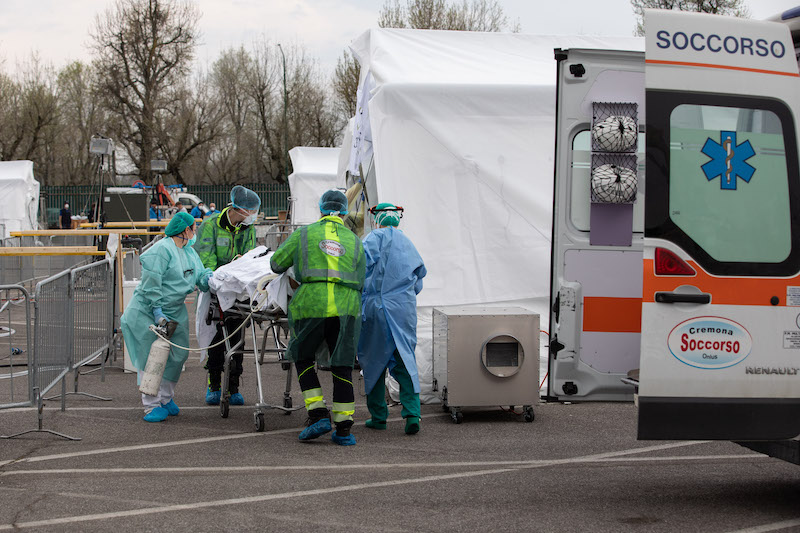
A patient arrives at the hospital in Cremona (Emanuele Cremaschi/Getty Images)
Family doctors
Once an epidemic has emerged, general practitioners – or family doctors, as they are often referred to – are the first line of defence for the population. People turn to them when they find out they have suspicious symptoms, and they are always the ones who know the community and care for it in a far-reaching way. About 7 thousand general practitioners, paediatricians work in Lombardy, included out-of-hours healthcare workers who play the same role as family doctors at night and during the holidays. During an epidemic, their main task is to provide the initial treatments: those that, in many cases, prevent patients from going to hospital where they risk transmitting the contagion to health professionals and other patients, contracting another illness or, simply, overloading a service that is already under strain.
Throughout February and the first weeks of March, family doctors continued to visit their patients often without any protective equipment, except for the few who were able to buy privately, whilst the modest stocks gathered by the Lombardy region were reserved for hospital staff, who were also in great difficulty. Because of their roles, family doctors suffered the first impact of the pandemic, and among health workers they paid the highest price: of the 150 doctors who died during the epidemic, almost half were family doctors.
Their long-standing difficult relationships with the rest of the regional healthcare system further complicated their work. «Our category has been completely abandoned to its fate», said Michele Marzocchi, a family doctor working in Milan. «We received nothing in the true sense of the word. We didn’t know how to act or what to do», said Renato Facconi, who works in a clinic in Vimodrone, in the province of Milan, and contracted COVID-19 at the end of February.
Since the beginning of the pandemic, general practitioners state that they have been working without guidelines on how to report and treat suspicious cases. Communications from local health directorates were often at odds with each other, and sometimes contained demands that were simply impossible to achieve. For example, some of them were asked to distribute masks outside their surgeries, but no protective equipment was delivered to them from the region and the stocks available in pharmacies quickly ran out.
In an ideal situation, family doctors are an essential link between the community and the healthcare system. When a positive patient is intubated and sedated, for example, the family doctor is the person who can most easily reach his or her relatives and other close contacts to warn them to go into isolation. However, the regional authorities have rarely been able to use them for that purpose.
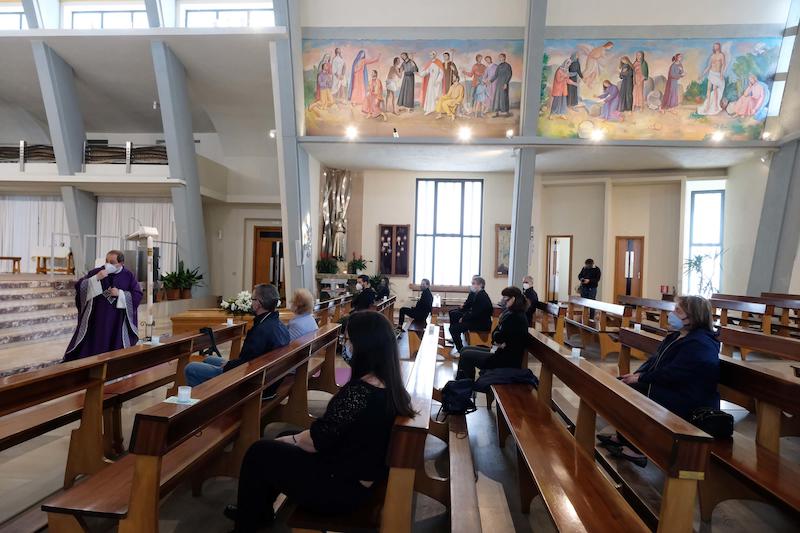
A funeral service in Brescia, May 4. (ANSA/Filippo Venezia)
Several doctors reported that they had found out that their patients had tested positive from their relatives. In other cases, without the telephone numbers of family members and with the patient unable to communicate, they hadn’t heard from their patient in weeks. Moreover, even at the end of April, it is almost impossible for family doctors to request a swab to check whether they or one of their patients is infected. According to one family doctor, after two coronavirus-positive cases emerged at a practice of six doctors, a letter had to be sent by a lawyer to the local healthcare company before a swab could be carried out.
The situation was particularly difficult in Bergamo, where there are fewer general practitioners than elsewhere. Here each family doctor has around 1,600 patients, compared to the regional average of 1,300, the number recommended by the guidelines of the Lombardy region. At the peak of the epidemic, out-of-hours healthcare workers in the province of Bergamo received up to 40 calls a day each. Furthermore, it was not just masks, gowns and gloves that were in short supply; there was also a shortage of saturometers and oxygen cylinders, two instruments needed to treat the mildest cases at home and avoid overloading hospitals. At one point, the shortage of cylinders became so serious that the Carabinieri had to go from house to house to retrieve the used ones that families were trying to keep in case of further deterioration.
The government of the Lombardy region is aware of these difficulties and the need to resolve them. A resolution passed by the Regional Council at the end of April calls upon the Council to demand that the national government transform general practitioners into fully-fledged regional healthcare employees. However, family doctors’ organisations have called this idea «a catastrophe». For them, this is yet another attempt to centralise healthcare in Lombardy and focus it on a sector that they believe has already received far too much attention: hospitals.
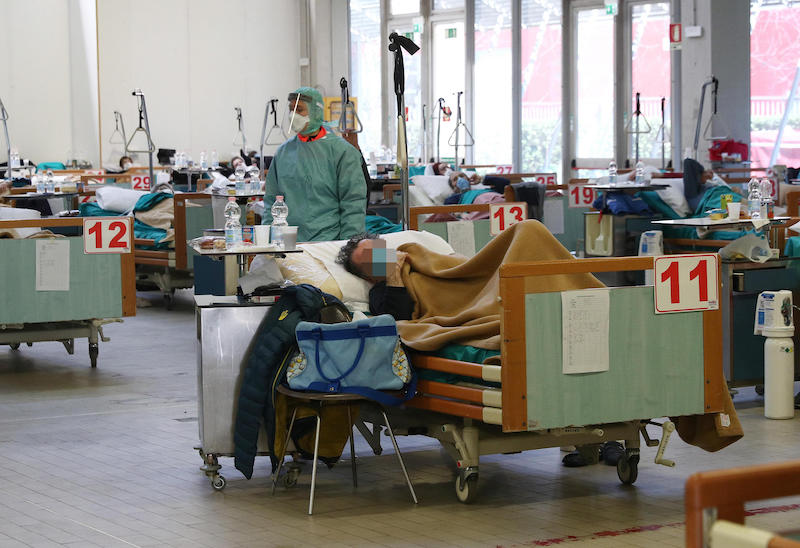
A makeshift hospital room set up next to Brescia’s hospital (ANSA/FILIPPO VENEZIA)
The rising tide
When the contagion in Lombardy proved impossible to contain and local medical practices were no longer able to stop it, it was the renowned hospitals in Lombardy that became the first line of defence in the fight against the epidemic. When trying to describe what happened during that period, doctors and healthcare workers have often used metaphors that evoke floods, waves, tsunamis, and the concept of an imminent danger of being submerged.
Numbers are not enough to understand what that meant in practice.
On March 4, while the government and the region were discussing the possibility of establishing a new “red zone” in Alzano Lombardo, there were around 2,000 confirmed cases in the region. 1,500 patients were hospitalised and about 200 were in intensive care units. Three days later, the number of people infected and hospitalised in intensive care units had doubled. In just two weeks, all these figures were to increase almost tenfold.
Faced with this wave of new cases, the hospitals’ first reaction was to deviate from their normal operations. In the hospital of Bergamo, as well as in those of Lodi, Cremona, Crema, San Donato, Brescia and several others, entire wards – in some cases entire floors – were converted to areas for coronavirus positive patients after the other patients were transferred elsewhere. Doctors of other specialities, such as dermatologists, urologists, cardiologists and nurses in other wards, were transferred to COVID wards after attending training courses quickly set up.
From the first week of March, the efforts of individual hospitals began to be coordinated by the regional crisis unit. All patients who needed non-deferrable treatments were transferred to 18 «hub» hospitals divided by specialisation, so as to leave as much space as possible in the rest of the region. The remaining 150 or so regional health facilities were converted into COVID-19 hospitals where the infected patients and the equipment needed to treat them, in particular ventilators and intensive care units, were centralised.
These soon became indispensable. When the infection in the lungs becomes so extensive that it prevents breathing, the only solution is to put the patient under anaesthesia and intubate him or her, i.e. administer oxygen directly into the lungs through a tube in the hope that in the meantime his or her immune system, helped by drugs, will be able to destroy the virus.
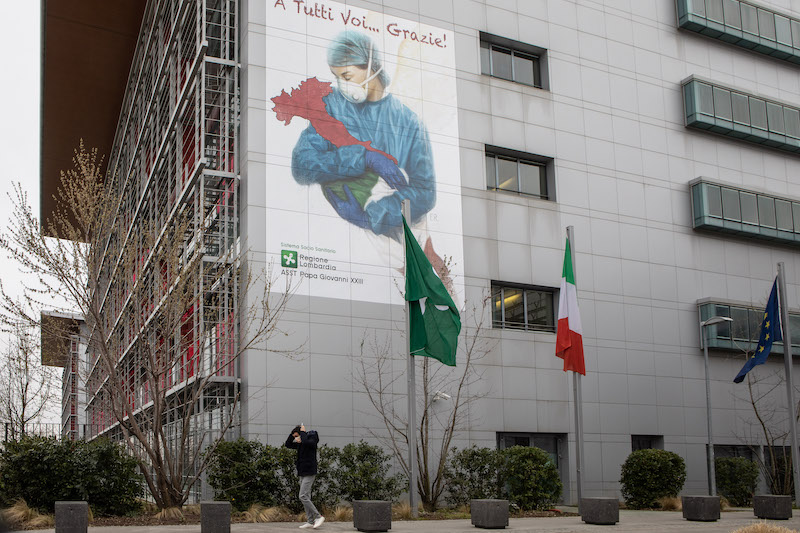
A huge poster outside Bergamo’s hospital, march 25. (Emanuele Cremaschi/Getty Images)
When the whole of Lombardy was put into isolation on March 8, the region had just over 700 intensive care units, almost 500 of which were already occupied by COVID patients. At this point, the main effort of the health authorities was to increase this capacity. The number of intensive care beds, those reserved for the most serious patients, was doubled and in some hospitals was even tripled, quadrupled, or more.
At the end of March, after a tremendous effort, the number of intensive care beds in Lombardy had been increased to 1,400.
According to an almost unanimous verdict, the Lombardy hospital system is the part of the regional healthcare service that has worked best in handling the crisis. On February 28, Facconi, the family doctor from Vimodrone, was admitted to San Raffaele Hospital in Milan, a private facility that before the emergency had only 4 intensive care units. This figure, helped by donations from private donors, had increased to 60 by the end of March. «In a time of great difficulty, they were able to rely upon their extraordinary abilities», said Facconi, remembering his time in the hospital. He also pointed out that generally-speaking, based on the experiences of colleagues and acquaintances, the management of all the hospitals has been up to the task and has bordered on heroism in the most severely affected provinces.
The price to pay for this success, however, was high. In Bergamo, the emergency in Val Seriana and the rest of the province was mainly dealt with by the large Giovanni XXIII hospital, where doctors and healthcare workers underwent exhausting shifts to keep the intensive and sub-intensive care wards running. In particular, during the early stages of the epidemic, when protective equipment was scarce, many staff were exposed to the infection but only a few underwent testing and even fewer were able to take time off.
The situations of the patients, who were isolated and unable to see their families, were also very challenging during that period. Thousands of people only learned of the death of a loved one after receiving a doctor’s call at the end of a gruelling shift. When the epidemic reached its pinnacle in the central weeks of March, doctors compared what they were experiencing to a natural cataclysm.
The number of people hospitalised during the peak of the crisis has been used by many to criticise the Lombard system and its management of the crisis that relied predominantly on hospitalisation, a natural reflection of the region’s health system. At the beginning of April, when admissions to hospitals in Northern Italy peaked in absolute numbers, Lombardy had hospitalised almost half of all the coronavirus positive patients in the region. In the same period, Veneto had a rate of coronavirus positive patients hospitalisation of around 25%. In the early stages of the epidemic the percentage had reached almost 80% in Lombardy, while it never exceeded 35% in Veneto.
According to Crisanti, the microbiologist who advised the Veneto region, «the epidemic is a battle that is won in the community and not in wards: hospitalising people who could be treated at home was harmful for the hospital itself». But despite these assessments, almost all the people who spoke with Il Post claim that during the period in question, in the hospitals of Bergamo, Cremona and Lodi, the three most severely affected provinces, only those who required specialist hospital care were hospitalised. The extremely high ratio between infected and hospitalised patients was not due to the over-use of hospitalisation, but rather to Lombardy’s long delay in acquiring swabs, which meant that only patients with severe symptoms could be tested.
The pressure on the hospitals only started to ease up after mid-March. At that time, whilst much of the attention was still focused on efforts to increase the number of intensive care beds, people were beginning to realise that although the hospitals had more or less managed to hold up, thanks to huge efforts, a different sector of the regional healthcare system was overwhelmed.
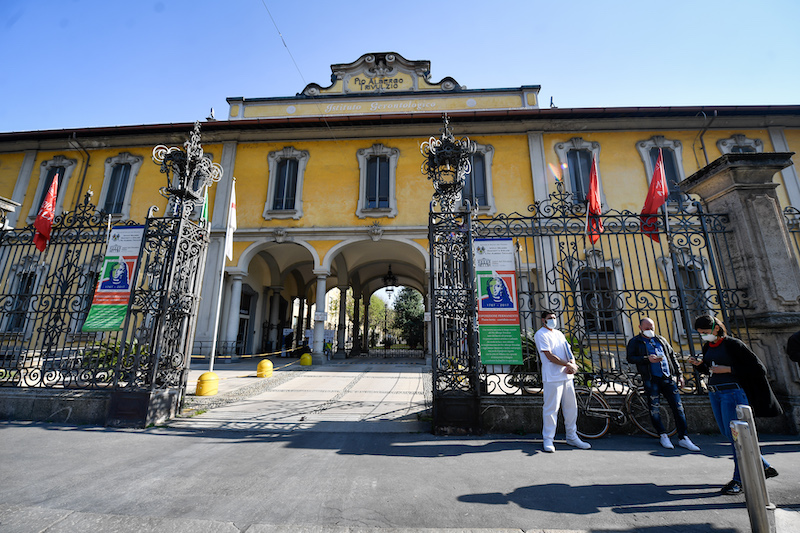
The Pio Albergo Trivulzio care home, in Milan (Claudio Furlan/LaPresse)
A disaster for residential care homes
The report on pandemic preparedness submitted by the Lombardy region’s specialists to the regional government in 2010 stated, in its last point, that the region had not taken any action to strengthen the protection of residential care homes, the nursing homes for dependent patients that mainly accommodate the elderly. During an epidemic, residential care homes are the weakest point of any healthcare system: they are places where, often in confined spaces, dozens and in some cases hundreds of elderly people, usually weak and suffering from previous illnesses, are housed.
Under normal conditions, residential care homes are facilities where people, relatives, doctors and nurses come and go all the time. During an epidemic it is easy for one of these people to carry the virus into the facility. At that point the transmission is almost guaranteed. In a place where people regularly need to be fed and washed, keeping a safe distance is impossible.
According to a dozen accounts obtained by Il Post, the situation has not improved since 2010. The region did not have enough protective equipment to distribute to doctors and nursing home workers, just as it did not have enough for all the other divisions of the community medical services. The complex organisational structure of regional healthcare added further complications, with several managers providing conflicting messages and guidelines. When a residential care home in the province of Bergamo announced that visits were suspended in an attempt to prevent the contagion from entering the facility, the local healthcare management was forced to reopen by regional authorities.
Other residential care home decisions in the region have become the subject of litigation and judicial investigations. When the situation in the hospitals had become critical, the Lombardy region decided to use residential care homes to accommodate non-serious COVID-19 patients: a choice that representatives of the nursing home associations called «lighting a match next to a haystack». Despite strong pressure from the region, only a dozen residential care homes accepted patients suffering from COVID-19. But although this decision is still one of the most controversial, in addition to being the subject of investigations by the judiciary, the contagion managed to spread even in residential care homes where COVID-19 patients were never admitted.
In a residential care home in Val Seriana, 45 out of 143 residents died in March alone: almost all of them had symptoms of COVID-19. In the residential care homes of the province of Bergamo, from January 1 to the end of April, 1,998 residents died out of a total of 6,100 which equals one third of residents and 1,322 more than in the same period of 2019. Similar numbers of deaths have been seen in scores of other facilities in the region.
The stories coming from nursing homes are among the most harrowing in the entire epidemic. The relatives of hospitalised patients gathered in groups on the internet to share their stories and ask for clarification about what happened to their relatives. «Where’s my mum?» Fernanda asked on April 22, in the group of Pio Albergo Trivulzio, the largest residential care home in the province of Milan. Shortly beforehand, the Trivulzio staff had informed Fernanda that her mother, who had tested positive for COVID, had been transported to the Sacco hospital, but the hospital seemed to know nothing about her case. Two days later, Fernanda wrote again in the group: «I just heard the news that my mum passed away this evening».
According to a report by the Istituto Superiore di Sanità [National Institute of Health], in February and March 1,625 people died across 266 Lombardy residential care homes from COVID-19 or influenza symptoms attributable to COVID-19. This figure is still incomplete because it concerns only a small number of the approximately 700 structures present in the region, but it seems to confirm a suspicion that has been circulating for some time: hundreds if not thousands of people have died in residential care homes without being tested, thus evading the official statistics.
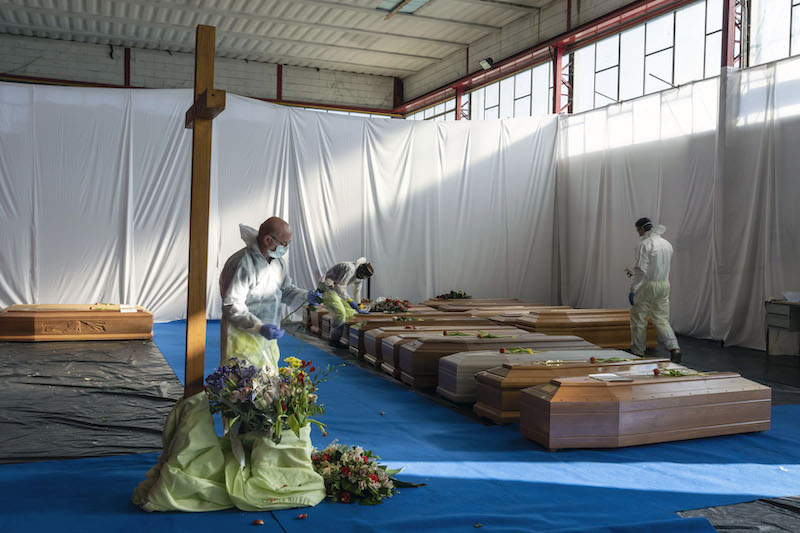
Caskets in Bergamo waiting to be moved to a crematorium in Florence, April 7 (Marco Di Lauro/Getty Images)
The regional authorities
For better or for worse, the main decisions on how to deal with the pandemic were made by the regional authorities and, more specifically, by two people: the president of the region, Attilio Fontana, and his councillor for Welfare and Health, Giulio Gallera. Having arrived relatively recently at the helm of the region following internal turmoil in their parties, Fontana and Gallera found themselves, against their will, dealing with the biggest health crisis since the war.
Fontana, president of Lombardy since 2018, is a 68-year-old lawyer who entered politics relatively late. In 1995, when he was already 43 years old, he was elected with the Northern League as mayor of the small town of Induno Olona, in the province of Varese. Following his subsequent term at the Regional Council, and after being twice elected mayor of Varese, Fontana was close to retirement and ready to end a political career that had never attracted particular attention. But when the clash between the secretary of the Northern League, Matteo Salvini, and the then president of Lombardy, Roberto Maroni, reached its pinnacle, Fontana suddenly found himself at the center of regional politics. Only three months before the elections Maroni announced that he did not want to run for a second term at the head of the Lombardy region as he hoped to obtain a position at national level. Fontana, who had not taken any particular side in the ongoing dispute and did not seem to pose a threat either to Salvini or Maroni, found himself the centre-right candidate for the position of president of the region.
After his victory in the elections, Fontana found himself flanked in his most important role, that of Councillor for Welfare and Health, by a politician younger but with more consolidated experience than his own: Giulio Gallera. Like Fontana, 51-year-old Gallera is also a lawyer; he has been in politics since he was 20. Gallera spent his entire career in Milan working with Forza Italia, the party of which he has been a member since its foundation. He was elected to the Regional Council in 2012 and, like Fontana, he also made a breakthrough following unrest within his party. In October 2015, in fact, Mario Mantovani, the then councillor for Welfare of the Maroni Council and regional coordinator of Forza Italia, was arrested on charges of corruption. Although he had no experience in healthcare, Gallera at the time was the most prominent figure in the Forza Italia caucus at the Regional Council: he was therefore chosen to replace Mantovani, holding on to this position even under the new council led by Fontana.
During the crisis, Fontana and Gallera played a central role in representing Lombardy’s response to the crisis. They gave dozens of interviews to national and international media, appeared almost daily on television and strongly defended their work. In practice, however, they were hardly involved in the technical management of the hospitals. In the first phase, hospital health directorates acted largely on their own initiative as they reorganised themselves amidst pressure from the growing number of cases. In the next phase, the organisation of the hubs for non-COVID patients, the reinforcing of intensive care units and the reallocation of doctors from one province to another were left to be managed by the crisis unit. Initially, talks with Gallera and Fontana were a daily occurrence, but since mid-March the crisis unit has been working more and more autonomously, merely sending the councillorship texts of circulars and resolutions to be approved.
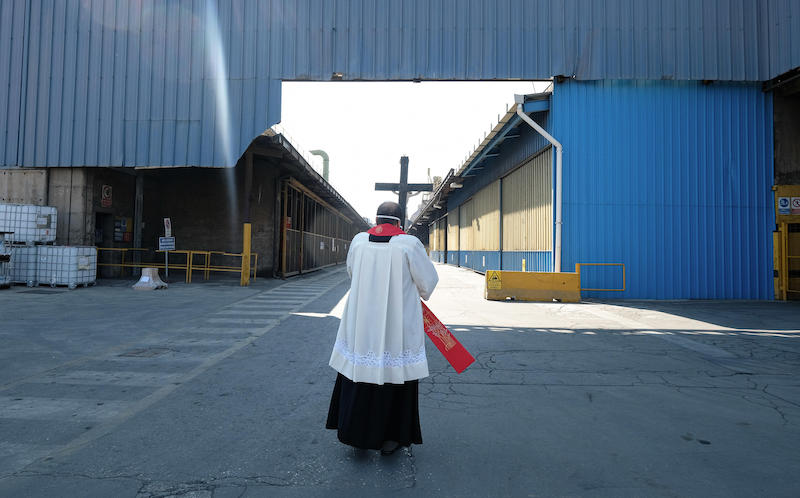
A priest blessing the Alfa Acciai plant in Brescia, Aprile 10 (ANSA/ FILIPPO VENEZIA)
Although technical coordination has largely been entrusted to experts and doctors, some key decisions have been taken by politicians based on priorities that do not always align with those related to public health. The decision to build a temporary hospital in the Milan trade fair buildings, for example, was taken by Gallera. Initially the hospital, costing around €20 million, was to have 400 intensive care beds but this was subsequently reduced to 200. When it opened at the beginning of April, it accommodated only 24 patients. Although increasing the number of intensive care beds can’t do any harm, given that we are dealing with an epidemic that could reach new peaks once restrictions are lifted, many have accused the region of placing too much focus on the temporary hospital at a time when their priorities should have been elsewhere instead of on raising publicity. The region has responded to these allegations by stating that the hospital will still be available if the epidemic numbers increase again in the coming weeks.
Another decision that generated great controversy was the hasty reopening of the hospital in Alzano Lombardo which occurred just two days after the closure of the hospital in Lodi and after it emerged that two of the hospitalised patients were infected. The order came from Luigi Cajazzo, a former policeman and chief executive of the health department. Gallera has defended the decision. In the days that followed, during discussions regarding whether or not to establish a new “red zone” in the Bergamo area, the region consulted at least once with the entrepreneurs’ associations to decide what to do. In the end it decided to accept the government’s decision not to create a new “red zone” despite the worrying situation and the fact that, in the meantime, other regions had autonomously set up reinforced quarantine zones following outbreaks that were much less significant than the one in Val Seriana.
The controversial decision to use residential care homes to accommodate COVID-19 patients is another area of concern in the regional management of the epidemic. Fontana attributed all the responsibility for this decision to the technical structures, but there is little doubt that the council as a whole backed the decision and pushed for it to be implemented. Pio Albergo Trivulzio in Milan, the structure responsible for allocating patients to the residential care homes, is under direct regional control, and the region lobbied for residential care homes to accept Covid positive patients. The manager of a nursing home in Milan said he had received dozens of phone calls for days from regional officials.
Doctors, mayors and citizens have harshly criticised Lombardy’s poor preparation regarding swabs and the lack of transparency and efficiency with which the region has managed contact tracing. The Lombardy region has never been able to carry out testing on all symptomatic patients, as provided for in the Ministry of Health guidelines: on the contrary, in most cases, and especially in the most affected areas, it has been able to perform tests almost exclusively on patients who are so seriously ill that they have been hospitalised. Furthermore, ISTAT [Italian National Institute of Statistics] mortality data suggests that thousands of people still died without ever being tested. For thousands and thousands of suspicious cases emerging in residential care homes and households, for example, tests were never carried out. Between March and April, anyone who had anything to do with the epidemic in the region confirmed this situation: «swabs are non-existent» Fabrizio Lazzarini, director of the largest geriatric facility in Bergamo, eloquently told Il Post.
Rather than acknowledging the problems and asking other regions or the Civil Protection for help, Gallera and Fontana have long denied their existence. In a letter sent to the mayors of Lombardy at the end of March, when the issue of swabs was now apparent, Fontana wrote that swabs were taken from «all subjects showing clinical symptoms compatible with the indications issued by the Ministry of Health». Several times during this period, Fontana stated that the Lombardy region «has strictly followed the protocols» on swabs, a statement that can be deemed false without fear of rebuttal.
The difficulty in asking for help and acknowledging the problems with managing the epidemic also stems, in part, from the relations that the regional government has with the government, which have continually fluctuated between bad and worse. The clashes started as early as February 25, just four days after the first contagion had been detected in Codogno, when the Prime Minister, Giuseppe Conte, claimed that an unspecified hospital in Lombardy had not followed the protocols. The next day Fontana abandoned a teleconference between the government and the regions in protest. Subsequently, Conte did not return to the subject and did not clarify his criticism.
Relationships haven’t improved over time. The region, for example, has accused the government and the Civil Protection of failing to supply enough masks and for not having provided the necessary materials to prepare the hospital at Fiera di Milano. Other minor disputes have marked the whole crisis. The daily regional press conference – effectively a simple live broadcast without any questions from journalists – for most of the epidemic took place at 6 pm, in direct competition with that of the National Civil Protection which took place at the same time. For its part, the government in Rome made no secret of its preference for the “Veneto model” the region which, since the end of January, had been in a position to carry out a large number of swabs and implement a more sophisticated contact tracing strategy.
In general, as the epidemic progressed and Lombardy became by far the worst affected region in the country, the administration became increasingly closed off in defence of its work. On April 8, for example, the Councillor for Civil Protection, Pietro Fioroni, stated «so far we’ve got everything right». Meanwhile Fontana defended himself in an interview, saying «they’ll challenge me about anything, but I’d do it all over again» only to add that perhaps he should have involved the opposition more.
The opposition, in fact, has never been involved in crisis management. Several regional councillors of the Democratic Party and +Europa-Radicali told Il Post that they had great difficulties in liaising with the majority and with the Northern League. For example, there is no public document outlining the components of the crisis unit. All questions and requests for clarification, whether from the opposition or the press, had to officially pass through Fontana and Gallera’s spokespeople who, overwhelmed by the sheer volume of requests, often failed to keep up with the need to provide further information both to the opposition and to the press.
In contrast to the national one, the regional daily press conference on the epidemic did not include questions from journalists. In the most severely affected regions, such as the Bergamo area, local healthcare facilities prohibited doctors and healthcare workers from talking to the press and several letters of formal notice were sent to those who proceeded to do so. In general, the region has lacked clarity when disseminating data and numbers on the crisis. The number of deaths by province, for example, together with other data and research that is potentially very important to reconstruct the history of the contagion in Lombardy, have still not been made publicly available.
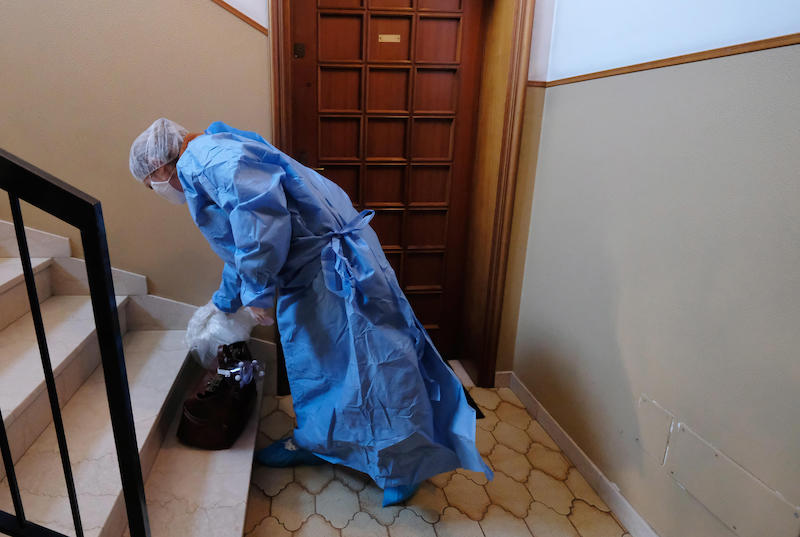
A doctor before visiting a patient in Brescia, march 31. (ANSA/FILIPPO VENEZIA)
The outcome
At the end of April, according to the official figures released by the region, in Lombardy almost 77 thousand people were infected and 14 thousand people died from COVID-19. There is consensus among experts and doctors that these numbers are a significant underestimate of what actually occurred in the region.
During the peak, an increasing number of doctors and patients reported symptoms clearly attributable to COVID-19, but reported that not only was it impossible to receive a swab, but that it was often difficult to receive medical assistance before symptoms significantly deteriorated. According to these accounts, very often medical assistance was only provided upon hospitalisation. At the same time several mayors, particularly in the province of Bergamo, began to record an unusual number of deaths which was much higher than the official number of deaths attributed to the coronavirus.
In the middle of the month, an unofficial count carried out by the municipalities of Bergamo, Alzano and Nembro showed a mortality rate compared to the previous year that was double, triple or even four times higher than the official coronavirus deaths. It soon became clear that one of the main reasons for this was the silent massacre that was taking place in residential care homes.
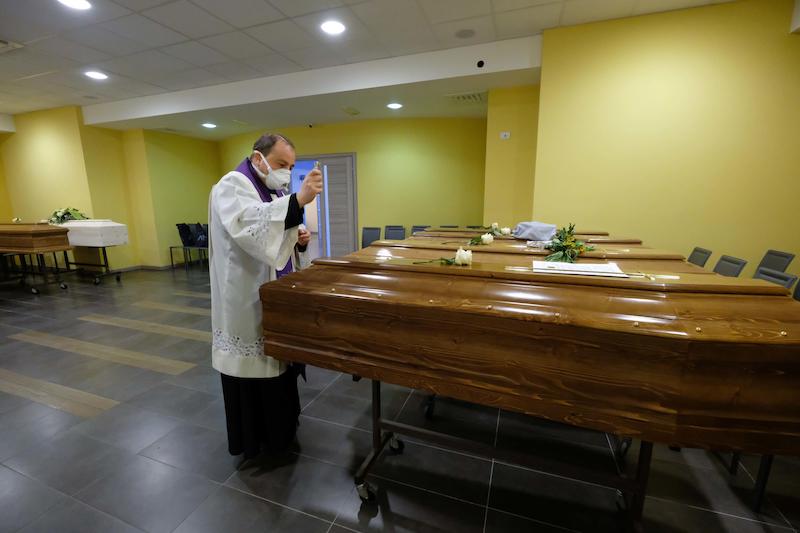
A priest blessing caskets in Brescia, Aprile 7 (ANSA / FILIPPO VENEZIA)
ISTAT, which records deaths from all causes almost in real time, has begun to detect excess mortality compared to previous years. The number recorded indicates not only those who died from COVID-19 who were not tested, but also those who died as a result of the overloaded health system. This includes patients who were not hospitalised due to full hospitals, people who, out of fear, did not visit the emergency room and others who did not receive ambulance assistance in time.
Even the official number of infected people has undoubtedly been largely underestimated. Against a backdrop of health facilities under pressure from the rising tide of cases, a region inadequately prepared to make a major effort to trace the contagion and community health services paralysed by long-standing conflicts, it has been and remains impossible to understand the real extent of the contagion. Those who contracted the virus but did not undergo testing do not exist in any official account.
Theoretically, the health agencies should have kept track of the most likely cases of contagion, i.e. people who had had close contact with those with confirmed cases, and subjected them to an improved monitoring system. But in reality, this task has proved to be beyond their capabilities, and not only because of insufficient testing. Stefania Bonaldi, Mayor of Crema, said that since the beginning of the epidemic the list of «contacts» of people who tested positive received from her municipality has always been shorter than the list of «confirmed cases». Tens of thousands of infected people, perhaps hundreds of thousands, have continued to be able to move freely and to live normally in their homes with their families, thus contributing to the spread of the disease.
It is only in the next few months that we will discover the true outcome of the epidemic, and perhaps we will never know the real numbers. It is not impossible that the final number of people who have contracted the disease is up to ten times higher than the official number. The number of people who have died as a result of the virus could be up to twice as the official number of confirmed deaths.
Faced with such large numbers, it is inevitable that many people are now looking for one or more culprits. The suspects are well-known. The crisis was managed by a regional government accused of being slow, unprepared and more attentive to its own consensus than to public health. The health system that has long neglected the community was focused on hospitals and poles of excellence. There was also an over-reliance on private individuals who, by their very nature, cannot offer the same regional support as public structures in an emergency situation.
Massimo Galli, virologist at the Sacco hospital in Milan and one of the most esteemed experts during the crisis, was among the toughest critics of this system. In a recent television interview he broadened the spectrum of his criticism, attacking the autonomy of the Italian health system, in which each region is free to do as it pleases and rarely lends significant aid and resources to others. «One of the lessons we can learn from this epidemic is that healthcare must be managed differently», said Galli. «I’m going to make a lot of enemies, but that’s something that can’t be helped». This is a criticism shared by many doctors who, during the peak of the epidemic, pointed out that it was easier to send patients to Germany than to have them admitted to Veneto, where in several hospitals two thirds of the beds in intensive care units were never occupied.
In addition to the region itself, which strongly rejected any criticism, many doctors and health experts in Lombardy have defended the regional system. All or almost all of them admit the weaknesses of regional healthcare, but they recall the successes of the hospital management and claim that the outcome would have been far worse if a region lacking Lombardy’s excellence and its high capacity for coordination had been dealt such a powerful blow.
The demographic and geographical configuration of Lombardy, a region characterised by medium-large cities, high population density and the highest number of exchanges with foreign countries and the rest of Italy, certainly played an important role. It is no coincidence that one of the most affected areas was Val Seriana, with its uninterrupted miles of warehouses and its intense commercial traffic.
Giuseppe Remuzzi, director of the Mario Negri Institute and a leading observer of Italian healthcare, is not likely to show any sympathy for the regional administration. But some critics of the system are now unwilling to talk. «It’s too early to make judgements», he told Il Post. In recent weeks Remuzzi has been working in Bergamo. From this tragically privileged observatory, he experienced first-hand the worst period of the pandemic, in which he lost friends, colleagues and acquaintances. According to him, the only thing that is certain at the moment is that what happened in his region was an unprecedented phenomenon. «There’s an element of bad luck in all this», he says. «A component of chaos and fortuitousness. Lombardy was hit first, suddenly and violently. No one had predicted it and there was no time to prepare».
We will probably never know to what extent human limitations have affected the severity of the epidemic. We will never know how many deaths have been caused by unmeasurable and unpredictable factors and how many by cuts in healthcare, by the strong focus on hospitalisation, by the lack of integration of the healthcare system with other regions, by the excessive concentration of private individuals in their search for profits or by the decisions and mistakes made by the regional government. Meanwhile in Italy, hundreds of people continue to die every day in hospitals and nursing homes, but it is probably too early to make final judgements. But now that limitations and errors have been put under the spotlight, and given that we will be living with the virus for a long time yet, it is not too late to start correcting them.
Il Post is a news site published since 2010: its mission is to explain and report the news. Since 2010 all articles on Il Post have been open and free for everyone to read: but readers can become members, join our community and support our work. If you are interested, you can start here.



